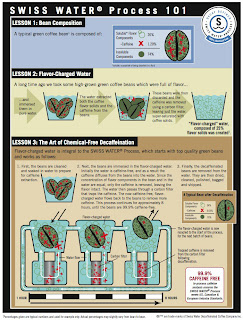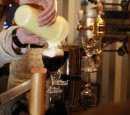Coffee Decaffeination is the act of removing caffeine from coffee beans. (While caffeine-free soft drinks are occasionally referred to as "decaffeinated", some are better termed "uncaffeinated": prepared without adding caffeine during production.) Despite removal of caffeine, many decaffeinated drinks still have around 1-2% of the original caffeine remaining in them.
Coffee Decaffeination process is usually performed on unroasted (green) beans, and starts with steaming of the beans. They are then rinsed with a solvent that extracts the caffeine while leaving the other essential chemicals in the coffee beans. The process is repeated anywhere from 8 to 12 times until it meets either the international standard of having removed 97% of the caffeine in the beans or the EU standard of having the beans 99.9% caffeine-free by mass. Coffee contains over 400 chemicals important to the taste and aroma of the final drink: it is therefore challenging to remove only caffeine while leaving the other chemicals at their original concentrations.
The first commercially successful decaffeination process was invented by Ludwig Roselius and Karl Wimmer in 1903. It involved steaming coffee beans with a brine (salt water) solution and then using benzene as a solvent to remove the caffeine. Coffee decaffeinated this way was sold as Kaffee HAG after the company name Kaffee Handels-Aktien-Gesellschaft (Coffee Trading Company) in most of Europe, as Café Sanka in France and later as Sanka brand coffee in the U.S. Café HAG and Sanka are now worldwide brands of Kraft Foods. Due to health concerns regarding benzene, this process is no longer used commercially and Coffee Hag and Sanka are produced using a different process.
 The Swiss Water Process is a method of decaffeinating coffee beans developed by the Swiss Water Decaffeinated Coffee Company. To decaffeinate the coffee bean by the Swiss Water method, a batch of green (unroasted) beans is soaked in hot water, releasing caffeine. When all the caffeine and coffee solids are released into the water, the beans are discarded. The water then passes through a carbon filter that traps caffeine but lets the coffee solids pass through. The resulting solution, called "green coffee extract (GCE)" by the company, is now available for decaffeinating coffee. New green coffee beans are introduced to the GCE. Since the GCE is coffee solids without caffeine only the caffeine diffuses from the new beans. The GCE passes through proprietary carbon which captures the caffeine. The process repeats, filtering out all the caffeine until the beans are 99.9% caffeine-free. These beans are removed and dried, and thus retain most if not all of their flavor.
The Swiss Water Process is a method of decaffeinating coffee beans developed by the Swiss Water Decaffeinated Coffee Company. To decaffeinate the coffee bean by the Swiss Water method, a batch of green (unroasted) beans is soaked in hot water, releasing caffeine. When all the caffeine and coffee solids are released into the water, the beans are discarded. The water then passes through a carbon filter that traps caffeine but lets the coffee solids pass through. The resulting solution, called "green coffee extract (GCE)" by the company, is now available for decaffeinating coffee. New green coffee beans are introduced to the GCE. Since the GCE is coffee solids without caffeine only the caffeine diffuses from the new beans. The GCE passes through proprietary carbon which captures the caffeine. The process repeats, filtering out all the caffeine until the beans are 99.9% caffeine-free. These beans are removed and dried, and thus retain most if not all of their flavor.
Although the process was pioneered in Switzerland in the 1930s, today the world's last major Swiss Water Process decaffeination facility is based near Vancouver, British Columbia,Canada. However this process is simple enough to be used locally by many coffee roasters.
In the direct method, the coffee beans are first steamed for 30 minutes and then repeatedly rinsed with either dichloromethane or ethyl acetate for about 10 hours. The solvent is then drained away and the beans steamed for an additional 10 hours to remove residual solvent. Sometimes coffees that are decaffeinated using ethyl acetate are referred to as naturally processed because ethyl acetate can be derived from various fruits or vegetables; but, because of the impracticality of gathering natural ethyl acetate, the chemical used for decaffeination is synthetic.

In the indirect method, beans are first soaked in hot water for several hours, in essence, making a strong pot of coffee. Then the beans are removed and either dichloromethane or ethyl acetate is used to extract the caffeine from the water. As in other methods, the caffeine can then be separated from the organic solvent by simple evaporation. The same water is recycled through this two-step process with new batches of beans. An equilibrium is reached after several cycles, where the water and the beans have a similar composition except for the caffeine. After this point, the caffeine is the only material removed from the beans, so no coffee strength or other flavorings are lost. Because water is used in the initial phase of this process, sometimes indirect method decaffeination is referred to as "water-processed" even though chemicals are used.
The CO2 decaffeination process is technically known as supercritical fluid extraction. In the carbon dioxide method, the caffeine is stripped directly from the beans by a highly compressed semi-liquid form of carbon dioxide. Pre-steamed beans are soaked in a bath of supercritical carbon dioxide at a pressure of 73 to 300 atmospheres. After a thorough soaking for around ten hours, the pressure is reduced, allowing the CO2 to evaporate, or the pressurized CO2 is run through either water or charcoal filters to remove the caffeine. The carbon dioxide is then used on another batch of beans. This liquid works better than water because it is kept in supercritical state near the transition from liquid to gas, combining favorable diffusivity properties of the gas with increased density of a liquid. This process has the advantage that it avoids the use of potentially harmful substances.
In triglyceride process, green coffee beans are soaked in a hot water/coffee solution to draw the caffeine to the surface of the beans. Next, the beans are transferred to another container and immersed in coffee oils that were obtained from spent coffee grounds. After several hours of high temperatures, the triglycerides in the oils remove the caffeine—but not the flavor elements—from the beans. The beans are separated from the oils and dried. The caffeine is removed from the oils, which are reused to decaffeinate another batch of beans. This is a direct-contact method of decaffeination.
 Almost all brands of decaffeinated coffee still contain a minimum amount of caffeine. Drinking five to ten cups of decaffeinated coffee could deliver as much caffeine as would one or two cups of regular coffee, according to research at the University of Florida Maples Center for Forensic Medicine. In one independent study of 10 popular decaffeinated coffees, researchers found that all but one contained detectable caffeine. The 16-ounce (473-milliliter) cups of coffee samples contained caffeine in the range of 8.6 milligrams to 13.9 milligrams. In another similar study of popular brands of decaf coffees, the caffeine content was anywhere from 3 milligrams up to 32 milligrams. Both of these studies tested the caffeine content of store-brewed coffee, suggesting the caffeine may be residual from the normal coffee served, rather than poorly decaffeinated coffee.
Almost all brands of decaffeinated coffee still contain a minimum amount of caffeine. Drinking five to ten cups of decaffeinated coffee could deliver as much caffeine as would one or two cups of regular coffee, according to research at the University of Florida Maples Center for Forensic Medicine. In one independent study of 10 popular decaffeinated coffees, researchers found that all but one contained detectable caffeine. The 16-ounce (473-milliliter) cups of coffee samples contained caffeine in the range of 8.6 milligrams to 13.9 milligrams. In another similar study of popular brands of decaf coffees, the caffeine content was anywhere from 3 milligrams up to 32 milligrams. Both of these studies tested the caffeine content of store-brewed coffee, suggesting the caffeine may be residual from the normal coffee served, rather than poorly decaffeinated coffee.
Consumption of decaffeinated appears to be as beneficial as caffeine-containing coffee in regard to all-cause mortality, according to a large prospective cohort study. In women, consumption of decaffeinated coffee significantly decreases all-cause mortality with a relative risk of between approximately 0.8 to 0.9 with a consumption of 1 up to approximately 6 cups per day, compared to those who drink less than one cup per month. In men, these beneficial effects are apparently not as great, but yet having a significant trend towards less mortality for those who drink more than 2 cups per day compared to those who drink less than one cup per month.
As of 2009, progress towards growing coffee beans that do not contain caffeine was still continuing. The term "Decaffito" has been coined to describe this type of decaffeinated coffee, and trademarked in Brazil. The prospect for Decaffito type coffees was shown by the discovery of the naturally caffeine-free Coffea charrieriana, a Coffea arabica plant, discovered in Cameroon in 2004. It has a deficient caffeine synthase gene, leading it to accumulate theobromine instead of converting it to caffeine. This trait could either be bred into other coffee plants by crossing them with Coffea charrieriana, or an equivalent effect could be achieved by knocking out the gene for caffeine synthase in normal coffee plants. [source : Decaf Coffee]


















